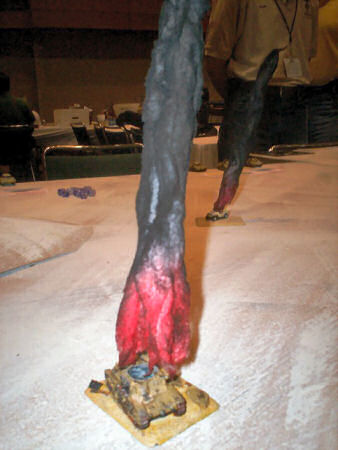For smaller models such as 1:600 scale jet aircraft, I find that simple magnetic basing is sufficient. By this, I mean one magnet on the tip of the flight stand, and another magnet near the bottom center of the model in question. The strength of the magnetic attraction is sufficient, not only to hold the model safely in place, but to reduce the possibility of the model accidentally spinning in place (i.e., changing its facing when bumped).
Since the Litko flight stands I've been using have a 1⁄8" diameter peg, I have found it convenient to use 1⁄8" diameter circular magnetic disks. I use thin (1⁄32" tall) disks on the models themselves, and thicker (1⁄8" tall) magnets on the flight stands.

However, the magnets - which I order from K&J Magnetics - are available in two strengths: N42 and N52. I've been buying the weaker N42 magnets because they cost less, but the difference in price is only $0.02 USD per magnet... so I more recently thought to test both magnet strengths.

Here are the two types of magnets. Well, actually, all you can see in the picture are the labeled Ziploc bags - but the magnets are in there somewhere.

And here are some 1:600 scale aircraft models (from Oddzial Ozmy, if I am not mistaken...), which have been primed white. (Ideally, you want to attach the magnets to the models before priming, to get a better bond... OK, I screwed up...)
So that I can keep things straight, one group of aircraft will get the N52 (stronger) magnets, and the other group will get the N42 (weaker) magnets.

Because the magnets will be subject to the occasional "snap" as they unite with each other, I prefer to use two-part epoxy to attach them, rather than the more convenient superglue.
It is important to keep track of the orientation of the magnets, because:
- we want the model to be attracted to the flight stand (not repelled!)
- and it will be convenient if all the models will work on all of the flight stands
Assuming that you've already glued a magnet to at least one of your flight stands (and given it 24 hours to dry!), what I've found easiest is to stack all of the magnets for the planes on top of the flight stand. This way, I know that the "top" of the magnet should be glued to the "bottom" of the aircraft model. (To keep from mixing up the N42 and N52 magnets, which are visually identical, I'm doing this in two separate batches.)

Now that all the models are ready, and the magnets are stacked, I'm ready to glue one set of the magnets. I squeeze a small amount of the epoxy onto a disposable surface (a plastic lid works) and stir it up with a toothpick until thoroughly mixed. Now the clock starts ticking... I've typically got five minutes or so to stick all the magnets down.
Using the toothpick, I put a small dot of the adhesive on the bottom of the model. I then slide the top magnet off the stack and hold it between my fingers, so that I keep it in the same orientation, and press it down into the epoxy (while trying not to get any of the epoxy on my fingers). The clean end of the toothpick makes a good tool for moving the magnet, if necessary, and tapping it to make sure it is flush to the model.
Once I've placed all the magnets, I go back to double-check the placement of the magnets. It is important to keep the models spaced apart, or the magnets will attract each other! Also, gravity may cause a magnet to slip from the bottom of a curved fuselage and wander onto a wing - if it does, push the magnet back while the epoxy is still yielding. I've also found it useful to tap all the magnets to keep them flush against the model, as sometimes they float up on top of the epoxy.
Once the epoxy was set, I did the second batch of magnets. And when they were done, there was nothing more to do until the epoxy had completely hardened - about 24 hours later...

So here's the moment of truth. When I put them on the flight stands...

...can I tell the difference?

And the answer is: Yes. As I pull the plane off the flight stand and put it back on, the stronger N52 magnets definitely have more of a kick to them. It actually takes some effort to pull the model loose. I'm surprised, as I didn't know how much difference there would be between the magnets.
In this application, which is better? I'm going to go with the N42 or weaker magnets, as they do what's needed fine - the stronger magnets are actually overkill, and no doubt put more strain on the adhesive. I can see how they would be useful with heavier models, though - larger aircraft, perhaps, or "taller" models (spacecraft).








